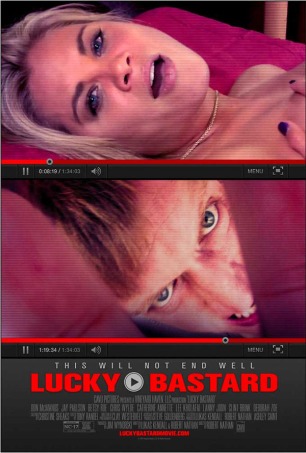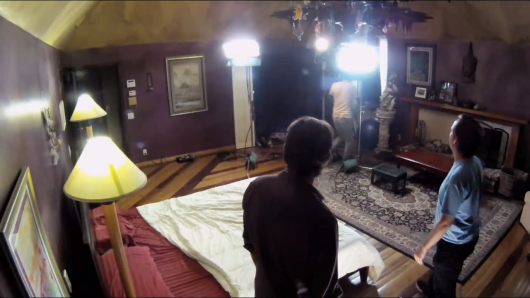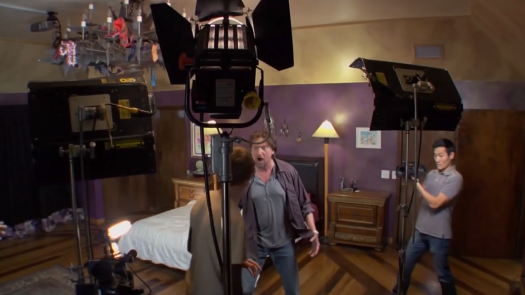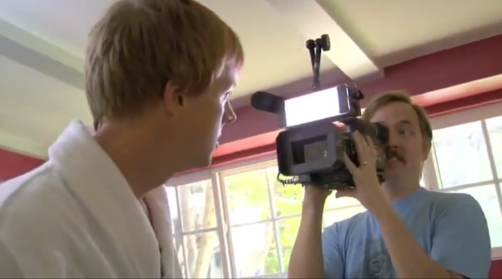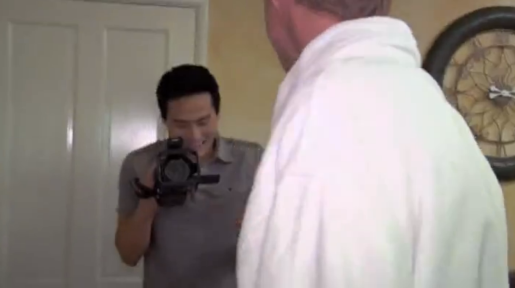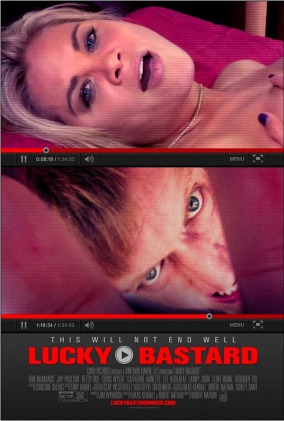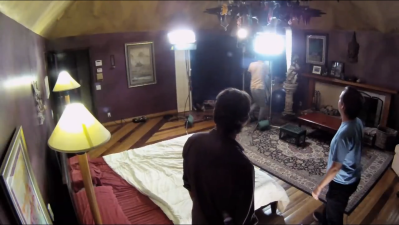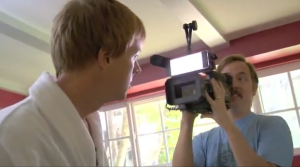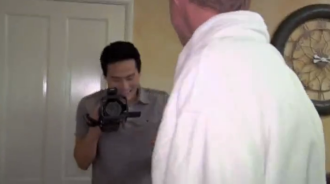Virtual Desires, Real Fears:
Immediacy and Hypermediacy in Lucky Bastard (2014)
“Shoot everything. Never stop shooting.”
—Mike, Lucky Bastard (2014)
The premise of a horror film made up of found footage has now become a cliché. Most likely due to the success of low-budget productions such as The Blair Witch Project (1999) and Paranormal Activity (2007), the found footage genre is all too familiar to us now. Robert Nathan’s recent addition to the genre, Lucky Bastard, released Feb. 14, 2014, might seem to be a cheap, poorly acted horror flick—and in many ways it is. Critics have panned the movie for its less than stellar performances and poorly crafted narrative. With plenty of gruesome murders, female nudity, and cheesy lines, Lucky Bastard is perhaps just another B-movie, but it still merits analysis. While watching, we may ask ourselves: What is real and what is simulated, and how does technology blur the line between the two? How does this found footage film reveal the danger of our desire for immediacy? And finally, what kinds of fears about technology and about society does the film portray? These questions will guide my analysis of the film and how it demonstrates the concepts of immediacy and hypermediacy in such a way that it calls the position of the audience into question.
To give some context, the movie tells the story of a fictional online porn site, “Lucky Bastard,” that invited fans to have sex on camera with porn stars. When Dave G. (Jay Paulson), a shy viewer down on his luck, is chosen to be the next “lucky bastard,” things start to go awry. He crosses the line with Ashley Saint (Betsy Rue), the porn star and single mother who reluctantly agrees to shoot the video, by using her real name, and even mentioning the names of her children. This raises Ashley’s suspicions and makes her wonder how Dave could have gained access to her private information. The crew even starts to realize that Dave is not the nice young man he claimed to be on the Internet, and much of the information he told them in his application turns out to be false. When it comes time to film, Dave ejaculates prematurely, cannot complete the scene, and is asked to leave. Enraged and humiliated by the cast and crew, he brutally murders everyone except for Ashley, who tricks him into letting his guard down, seduces him, and then kills him.
Blurred Lines: Reality and Simulation
Somewhat like Strange Days (1995), Lucky Bastard begins with a scene that disorients the audience’s sense of what is “real.” In this scene, Ashley Saint enters a house to find several people shooting a hardcore rape-fetish pornography scene. Shocked and offended, Ashley calls off the shoot and convinces the actress, Casey, to leave the set. When Ashley goes to follow her, she is confronted by one of the actors, who pins her down and begins to rape her. The viewer cringes in horror, until all of a sudden Ashley begins laughing. The crewmembers emerge from off-screen, and we realize this has been part of the same video—it was all just part of the act, part of the show. This opening sets the tone for the rest of the movie (which was rated NC-17 for its explicit content) because our sense of real and fake is completely thrown off.
The film seems to portray the behind-the-scenes aspect of online pornography—it’s the “real” story of how videos are made. For example, we mainly know Ashley Saint as her real self, Michelle, the young mother just trying to make ends meet, rather than the fake adult actress persona she has constructed. However this “real” look at adult entertainment actually reveals the fakeness of everything we see. For example, we witness multiple takes of the same scenes from several, omnipresent cameras. Thus, nothing can be taken as purely authentic—it has all been edited, reshot, or planned in a certain way. Right from the beginning, we realize the separation between reality and fiction is slipping.
The filmmakers could not have picked a better industry to highlight the blurred line between reality and fiction than the adult entertainment industry, where simulation and reality are so intertwined that it’s almost futile to try to tell them apart. The nature of the Lucky Bastard site further blurs this line. For example, the fact that the site allows “average Joe” viewers to cross over and become part of the spectacle troubles the separation between reality and fiction as virtual and physical worlds collide, and the spectator becomes an actor in the video. Even Ashley recognizes the danger of combining these two worlds: “No amateurs!” she tells Mike, the creator of the Lucky Bastard site and director of the videos.
Even the movie’s trailer walks the line between reality and fiction—trying to convince us at first that this is the real found footage of the Lucky Bastard site but then citing critics who claim that the movie is “extremely successful… quite convincing” and that it “takes the ‘found footage’ premise in new directions” seconds later. In addition, unlike The Blair Witch Project and Paranormal Activity, which feature unknown performers, Nathan casts somewhat recognizable actors (Jay Paulson even had a small recurring role on Mad Men), and this prevents the audience from believing the premise of the movie. Believability may not be the goal, but Nathan does not even try to convince us. Perhaps Lucky Bastard shows us that the “real” actually means very little; rather, the semblance of realness and what you can elicit from your audience are what count.
Immediacy and Hypermediacy
How does the film go about creating the semblance of realness? Paradoxically, it’s through more mediation—more cameras, more angles, more takes. Jay David Bolter and Richard Grusin explain this dynamic in their book Remediation: Understanding New Media. Remediation (the refashioning of one medium into another) involves the dual logics of immediacy and hypermediacy, where immediacy is defined as the erasure of a medium, and hypermediacy indicates the presence or multiplication of media. Bolter and Grusin argue that hypermediacy is often used to achieve a sense of “liveness” (immediacy) for the audience: “ideally [our culture] wants to erase its media in the very act of multiplying them” (5), and this is true in Lucky Bastard.
The movie consists mainly of footage shot by the site’s crew, with the exception of footage from security cameras and some police footage at the beginning. In just about every shot, there are cameras or screens present, revealing the film’s hypermediacy, which extends even to the film’s poster. The poster displays pictures of Youtube video screens with lower quality images of Ashley and Dave, suggesting that of an online video. The two screens juxtapose the themes of the film: sex and death. In addition, the poster demonstrates how consumption informs aesthetics. The film’s poster perhaps seeks to appeal to the same audiences that the fictional Lucky Bastard site might attract.
This advertisement invokes one medium (the Internet) while advertising for another (film). Calling such explicit attention to media also contributes to the film’s hypermediacy, which makes sense because film and the Internet are essential to the plot. There is also some remediation at play here—one medium (the porn film) has now been replaced with another (the porn online video). This also makes Lucky Bastard a postmodern movie because it heavily features the Internet and the idea of virtual space, which Marita Sturken identifies as characteristic of postmodernity in her article “Mobilities of Time and Space.”
The Appeal of Found Footage
As a found footage film, Lucky Bastard follows a long line of horror movies that have used this technique to frighten audiences in new ways. Some argue that the genre began with Cannibal Holocaust, a 1980 Italian film featuring found footage from an alleged documentary crew that went missing while filming cannibal tribes in the Amazon. The Blair Witch Project (1999) popularized the technique, showing audiences that using found footage to place the audience in the shoes of the characters can create a whole new kind of suspense. As seen in films such as Cloverfield (2008), “found footage” has even started spreading into other genres (sci-fi, action, adventure). I think what makes found footage successful, especially for horror, is how it plays with what audiences are allowed to see. Our perspective is restricted, which results in great suspenseful moments.
According to one screenwriter John Swetnam, found footage is perfect for the horror film “because it puts you in the shoes of the story. You get to experience those scares in a more visceral and direct way,” and it allows filmmakers “to get the audience closer to your story; to immerse them in the world you’ve created” (Screen Rant). However, we cannot forget the mediation involved in found footage films; everything that we see is mediated through a camera. Oddly enough, this is actually what makes found footage easier to watch than subjective shots, even though they both restrict the audience’s perspective, making us see only what the character sees. In this way, the found footage genre plays with the dual logics of immediacy and hypermediacy; more mediation can create a sense of liveness while also creating suspense by limiting our perspective.
What makes Lucky Bastard so interesting is that it alternates between satisfying our desires for blood and sex and frustrating them by restricting our view. For example, sometimes we witness intimate sex scenes between Ashley and Dave, but at other times, footage seems deliberately withheld. For example, in one scene, when Dave murders a woman who happens to drop by the set, we see him sneak up behind her and raise a baseball bat to strike her. We do not actually see Dave strike and kill the woman; there is a cut to a different camera angle, which restricts our view. This is perhaps because the filmmakers did not want to show such gratuitous violence. However, because the movie shows its audience so much (we often see graphic content and the same scenes shot from multiple cameras), I think restricting the audience’s view serves to trouble our voyeurism and create suspense in the film.
The Danger of Immediacy: Spectator as Voyeur
I do not think it is by accident that Lucky Bastard combines pornography and horror; film critics have often linked these two things. For example, critic Janet Maslin compares slasher films to pornography while arguing that slasher films do not produce a sense of catharsis (which is often considered to be the role of scary movies): “the stripped-down, impersonal bloodbath movies to which I’ve been referring do nothing of the kind [in terms of providing catharsis], any more than sexual pornography fulfills a viewer’s romantic longings” (cited in Sipos 253). Despite the disapproving nature of Maslin’s argument, I think that her connection between certain horror films and pornography reveals the complex position of the spectator. Her comment leads us to ask, if we aren’t watching slasher movies for catharsis or pornography to fulfill romantic longings, then why are we watching? I think that the answer points to a kind of scopophilia, and in the case of Lucky Bastard, perhaps a fairly sordid or perverse scopophilia.
As viewers, we want to see everything, and I think the film is conscious of the audience’s desire to see all. Earlier, I mentioned the number of cameras on display in nearly every shot. Because the movie revolves around the filming of a video, multiple cameras are often in view (see below for examples).
Cameras cover nearly every angle of the bedroom. Mike, the director of the video, even explains that the house is filled with cameras because it was originally the set of a reality television show.
The omnipresence of cameras and the hypermediacy of the film are no doubt driven by the audience’s desire for immediacy. Viewers want access to every aspect of the “lucky bastard’s” encounter with Ashley Saint. In the film’s trailer, the Lucky Bastard site boasts that its videos are “raw,” “uncut,” and “uncensored.” The dual logics of immediacy and hypermediacy are at work; more media is used to bring us closer to what it represented on screen. The site’s fans want to see everything, as if they are there in the room with the actors or even so they can imagine that they are the “lucky bastard.” Immediacy (achieved through hypermediacy) seeks to eliminate the distance between the viewer and what they see on screen, but Lucky Bastard shows us that this can have negative results.
While watching, we realize there is a perverse power kindled by hypermediacy and immediacy. The site’s viewers can see whatever they want, feel up close and personal, while remaining safely detached because the medium still separates them from the people on screen. Lucky Bastard reveals the dangers of this kind of voyeurism when Dave is humiliated on set do to his inability to perform. He begins shouting that he wants to complete the scene with Ashley (“I want to f— her! When do I get to f— her?!”), sending the two cameramen into fits of laughter. The extreme, almost claustrophobic close-ups on Dave’s face—filmed by not just one but two cameras simultaneously—reveal his anger to the audience. The cameras zoom in, penetrating Dave’s personal space and turning his private, personal embarrassment into public viewing material and public entertainment. This is how the film calls the audience’s desire for immediacy and our voyeuristic (perhaps even sadistic) position into question.
In the photos above, the cameramen film Dave, mocking him as he shouts, “I want to f— her!” We can even see the second cameraman laughing in the bottom photo.
Dave’s face fills the screen as the camera zooms in on him in an invading close-up.
Our Desires, Our Fears
Even unconsciously, horror films often reflect the fears of their current moment. For example, Cloverfield is clearly riddled with post-9/11 anxieties, while sci-fi and horror movies from the post-Cold War era reveal worries about invasion from strange places as well as fears that enemies could be lurking anywhere—even within the home (e.g. Invasion of the Body Snatchers (1956)). In a similar fashion, Lucky Bastard reveals the anxieties of our postmodern culture concerning technology and the virtual world, specifically the dangers of instant gratification and the Internet.
In certain ways, different characters stand in for the audience. For example, Dave represents the spectator because he is a viewer seeking the ultimate immediate experience—he wants to stop watching porn and start participating; he wants the medium to disappear completely. But when the experience doesn’t go the way he wants, he explodes. Mike responds to Dave’s outburst: “This is what’s wrong with America right here; everyone thinks they’re entitled to whatever f—ing thing they want!” which might also sum up today’s audiences fairly well—we live in a world where everything we could ever want to see or experience is at our finger tips. Here we see a drawback of our culture of instant gratification as the film points out the danger of expecting our desires to be fulfilled as quickly in real life as they are in cyberspace. We see what happens when the barrier between the viewer and his fantasy begins to disappear and he no longer has complete control—frustration, anger, and madness ensue.
We also see a reflection of ourselves in Ashley Saint, who feels threatened by Dave and his knowledge of her personal life. Technology has removed almost all limits of privacy, and the film acknowledges this. For example, Casey suggests that Dave discovered Ashley’s real name on a website that published a list of porn stars’ STD test results. Nothing, not even our most intimate information, is secret. Worrying about the violation of her privacy and what will result from humiliating Dave on camera for the public to see, Ashley expresses the fears of and about our postmodern, technologically advanced society.
Finally, I think the last moment of the film works very well in confronting the voyeuristic gaze of the audience. After Ashley has seduced and killed Dave, she turns to the camera pointed at the bed, stares into it with a look of disgust and reproach, and then she turns it off. The screen goes black, and the film is over. Thus, the last thing the audience feels is a strange sense of shame for having been witness to the perverse events of the film.
As Janet Maslin has suggested, films like Lucky Bastard do not always provide catharsis. She continues to say that the impersonal slasher film “works against any possibility of release, since it deadens the audience and creates a feeling of utter hopelessness” (cited in Sipos 253). I would not go as far to say that viewers are utterly hopeless at the end of Lucky Bastard, but we are certainly left with some troubling questions about our position as viewers and as citizens of a world that has both physical and virtual domains. I think what is frightening about the film is that it’s about us; we are all a little bit of Dave and a little bit of Ashley—we desire immediacy, instant gratification, and complete control over our fantasies, but we also fear the uncontrollable nature of the virtual world, where privacy seems to lose its meaning. Even though the film may not be spectacularly well done, Lucky Bastard certainly captures the state of today’s postmodern world, where the lines between virtual and physical realities and between public and private spaces are blurring more and more, and where the solutions to these issues are anything but clear cut.
Works Cited
Bolter, Jay David and Richard Grusin. Remediation: Understanding New Media. Cambridge, MA: MIT Press, 1999. PDF accessed via Sakai.
Lucky Bastard. Dir. Robert Nathan. Perf. Don McManus, Betsy Rue, Jay Paulson. Vineyard Haven, 2014. Internet.
“Lucky Bastard Official Trailer (2014).” YouTube. Online video clip. Youtube.com Accessed 1 March 2014. < http://www.youtube.com/watch?v=SWSRpZi1Msk>.
Sipos, Thomas M. Horror Film Aesthetics: Creating the Visual Language of Fear. Jefferson, NC: MacFarland & Company, Inc. Publishers, 2010. Print.
Sturken, Marita. « Mobilities of Time and Space: Technologies of the Modern and the Postmodern. » Technological Visions: The Hopes and Fears that Shape New Technologies. Ed. Marita Sturken, Douglas Thomas, and Sandra J. Ball-Rokeach, 71-91. Philadelphia: Temple University Press, 2004. PDF accessed via Sakai.
Swetnam, John. Interview by Rob Frappier. “Interview: Why Are Found Footage Movies So Popular?” Screen Rant. Web. 29 April 2014. <http://screenrant.com/popular-found-footage-movies-robf-154762/>.
